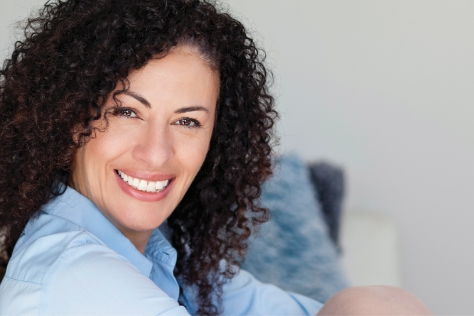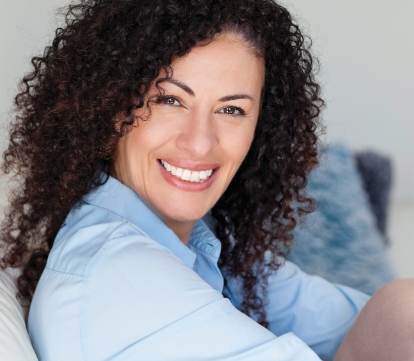- Home
- Injections
- Laser Treatments
- Specialties
Specialtiesview all
- Other Treatments
- Before After Photos
Before After Photosview all
- Contact Us
- Doctor And Staff
- About Celibre
- Blogs
Adding Volume To The Aging Face Using Injectable Fillers
Avoiding Bruises Associated With Injection Procedures
Botox And Restylane Technique, What Went Wrong?
Botox Restylane And Juvederm Lip And Mouth Enhancement
Does Grinding My Teeth Cause Migraines?
Do Cosmetic Injections Botox Juvederm Restylane Perlane Hurt?
Fat Injections or Dermal Fillers?
Injections For Dark Circles Under The Eyes
Needles vs Cannulas – Does it matter?
Not Liking Your Neck? Is Kybella an Option?
What Can I Do To Improve My Chin?
What Happens After The Restylane Juvederm or Perlane Has Dissolved?
What Is The Difference Between Botox And Restylane?
What Is The Difference Between Botox and Dysport?
What Is The Difference Between Restylane, Juvederm and Perlane?
3 Most Common Areas To Use Botox
Botox Cosmetic For Shaping The Face
How Can Men Benefit From Botox?
How Can Men Benefit From Cosmetic Dermal Fillers?
How Long Does Botox Take To Work?
How Many Units Of Botox For Forehead?
What Is A Botox Good Faith Exam?
What Is The Botox Black Box Warning?
What Is The Downtime With Botox Injections?
Who Is Qualified To Administer Botox Cosmetic?
Why Are Botox Prices Different?
Why Cheap Botox Is Not Necessarily Good Botox
Is There A Treatment For Underarm Sweating?
What Treatments Are Available For Crows Feet Lines Around The Eyes?
Asian Nose Shaping With Radiesse
Hand Rejuvenation Using Injection Procedures
Hand Rejuvenation What Does It Mean?
Restore Volume To Hollow Cheeks
Why We’re Not Currently Using Voluma By Allergan?
Chin Rejuvenation With Restylane
How Long Does Restylane Lyft (Perlane) Last?
Is There Downtime For Restylane Treatments?
Los Angeles Restylane For Eye Bags
Perlane (Restylane Lyft) Injections For Cheek Deformity
Philtral Columns And Mouth Rejuvenation
Restylane Injections For Textured Scars
The Aging Face Temporal Hollows
What Is A Mouth Frown And How Can It Be Corrected?
What Is The Tear Trough Injection Procedure?
How Is Sculptra Different Than Other Dermal Fillers?
Sculptra for the Buttocks? What you don’t know matters.
Can Freckles Be Treated With Lasers?
Can Laser Darken Permanent Makeup?
Can Threading For Hair Removal Have Any Effect On The Skin?
Eye Rejuvenation With Restylane And Laser Resurfacing
Fake Tanning And Laser Treatment
How Do Cosmetic Medical Lasers Work?
How Do Lasers Treat Large Pores?
How To Get Rid Of Hemosiderin Staining?
Lasers For Hyper-pigmentation And Brown Spots
Lasers; What Does Fad Approval Mean?
Laser Treatments Before And After Pictures
Laser Treatments For Dark Skin
Laser Treatments For Nevus Of Ota Birthmark
Laser Types And Wavelengths; What Does It All Mean?
Photo-dynamic Therapy Side Effects
Side Effects Of Photo-dynamic Therapy
Skin Orange Peel Texture Laser
Techniques For Treating Vertical Mouth Lines
The Gold Standards For Laser Dermatology
Treating The Aging Face For Pore Size
What Are Smokers Lines and How Do I Get Rid Of Them?
What Causes Crepey Skin Around The Eyes?
What Does Facial Rejuvenation Mean?
Who Can Perform Laser Treatments In California?
Why Does Celibre Medical Choose Lasers Over Ipls?
Why Does Celibre Use A Variety Of Lasers?
What Is Post Inflammatory Hyper-pigmentation?
What’s The Difference Between Tattoo And Permanent Makeup Removal?
Antibiotics And Lasers For Acne
Difference Between Acne And Milia
Do Oral Contraceptives Help With Acne?
Downtime With Acne Laser Treatments
How Does Laser Acne Treatment Work?
How Many Acne Laser Treatments Will I Need?
Number Of Laser Treatments For Acne And Milia
What Is Acne Rosacea And What Causes It?
What Is Blu Light Acne Treatments?
Acne Scar Removal; How Many Treatments?
What Is The Best Treatment For Depressed Acne Scars?
Will Acne Scars Improve After Laser Treatments?
Frosting Laser Treatment Sun Spots
How Does The Laser For Acne Scars Work?
How Do Lasers Remove Sun Spots And Freckles?
How Many Laser Treatments For Age Spots?
Treating The Aging Face For Sun Spots
How Many Laser Treatments for Cherry Hemangiomas?
Why Am I Getting Cherry Hemangiomas?
Birthmark Removal; How Many Laser Treatments?
Can A Port Wine Stain Be Treated With Lasers?
Is Laser Birthmark Removal Effective?
Is Laser Birthmark Removal For Me?
Lasers For Port Wine Stain Birthmarks
My Birthmark Has Hair In It, Are Laser Treatments Appropriate?
Speckled Nevi Birthmark Removal
Which Kinds Of Birthmarks Can Be Treated With Lasers?
Why Are Q Switched Lasers Best For Birthmark Removal?
How Does Laser Hair Removal Work?
How Long Does Laser Hair Removal Last?
How Many Treatments For Laser Hair Removal?
How Painful Can Laser Hair Removal Be?
Is Black Skin Laser Hair Removal Safe?
Is The Lumenis Lightseer The Most Common Laser Hair Removal Laser?
Laser Hair Removal For Ingrown Hairs
Laser Hair Removal Polycystic Ovarian Disease
Razor Bumps Laser Hair Removal
Red Bumps After Laser Hair Removal
What Is The Cost Of Laser Hair Removal?
What’s The Best Laser For Hair Removal?
Celibre Medical Prefers Erbium Over Fraxel
Fractional Laser Resurfacing For Eye Wrinkles
Fractional Laser Resurfacing For Forehead Scars
Fractional Resurfacing. Heat Matters!
Laser Treatment for Rhinophyma
Los Angeles Fractional Laser Resurfacing For The Eyes
Options For Laser Skin Resurfacing
Profractional Laser Resurfacing For Birthmark Removal
Recovery For Deep Profractional Laser Resurfacing Los Angeles
Side Effects Of Laser Hair Removal
Top 3 Laser Resurfacing Lasers
What Is Co2 Laser Resurfacing?
What is Erbium Laser Resurfacing?
What Is Fractional Laser Resurfacing?
Why All Fractional Resurfacing Is Not The Same
Can Poikiloderma Be Permanently Removed?
Expected Poikiloderma Results From Laser Treatments
How Many Laser Treatments For Poikiloderma?
Poikiloderma – Discoloration to the Neck and Chest
How Many Laser Treatments For Rosacea?
What Is A Bruising Treatment For Rosacea?
Can A Keloid Scar Be Permanently Removed?
Can Lasers Remove Chicken Pox Scars?
How Can I Get Rid Of Red Scars?
Scar Removal; How Many Laser Treatments?
Can Lasers Treat Spider Veins On The Face?
How Can I Prevent Spider Veins?
How Do Lasers For Spider Veins Work?
How Many Laser Treatments For Spider Veins?
Sclerotherapy Lasers For Spider Veins
Spider Veins or Varicose Veins?
Can Dark Stretch Marks Be Treated?
Can I Get Laser Treatments For My Stretch Marks While I’m Pregnant Or Breastfeeding?
Do Lasers Work For Stretch Marks?
How Can Brown Stretch Marks Be Treated With Lasers?
How to Get Rid of Red Stretch Marks?
Stretch Marks Treatment Options
Tummy Tuck or Lasers For Stretch Marks?
What Causes White Stretch Marks?
Will Lasers Completely Remove Stretch Marks?
Best Lasers For Tattoo Removal
Elimaink Wrecking Balm Tattoo Removal
Hives After Laser Tattoo Removal
How Does Laser Tattoo Removal Work?
How Many Treatments For Laser Tattoo Removal?
Long Beach Laser Tattoo Removal
Top 3 Lasers For Tattoo Removal
Will My Tattoo Be Completely Gone After Laser Treatments?
How Can I Get Rid Of Veins On My Hands?
What About Our Hands? Options for Hand Rejuvenation
What Is Latisse And How Does It Work?
Lip Spot Removal Associated With Peutz Jeghers Syndrome
Want Great Lips? Choose A Great Injector
Difference Between Melasma And Sun Damage
MELASMA – A Frustrating Condition
What Are Skin Tags And How Are They Treated?
Syringoma Removal With Cauterization
Can Warts Be Treated With Lasers?
Laser Treatments For Wart Removal
How Do I Get Rid Of The Wrinkles Between My Eyebrows?
What’s The Best Treatment For Wrinkles Around The Eyes?
Which Lasers Are Good For Wrinkles?
An Outsider as an Insider in Medical Aesthetics
Educating Our Patients; It’s What Makes Us Different
Healthy Ph Balance For The Skin
Nail Fungus – Lasers Prove Viable Treatment Option
What Do I Need To Know About Sunscreen?
What Is An Accessory Extra Nipple And How Is It Treated?
Every patient that visits Celibre Medical has a unique story to tell. Although many come to look refreshed and younger, others have an emotional skin condition that compels them to consider cosmetic treatments. Of the thousands of patients we have treated for every type of cosmetic injections and laser resurfacing procedures we offer, we’d like to share two of our patient’s stories with you. Meet “Sylvia” and “Jeff”.
“Sylvia” is a young patient that came to us with concerns over numerous, dark brown scars over her entire lower legs. When she was younger, Sylvia lived in an area that had many mosquitoes. Over the years, these relentless insects left her with many hyper-pigmented (dark brown) scars. Although these were easily covered by wearing pants, this was not an option any longer as she prepared to be part her friend’s wedding. Knowing that the special occasion was nearing, Sylvia began laser treatments to gently and progressively fade the scars. On her last visit, Sylvia shared with us, “I finally wore a dress for the first time in years!”
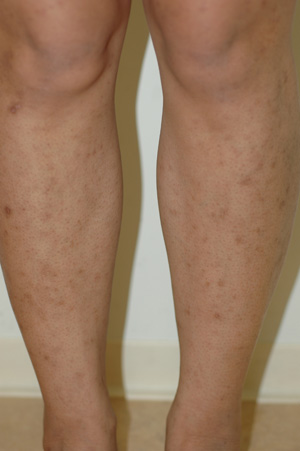
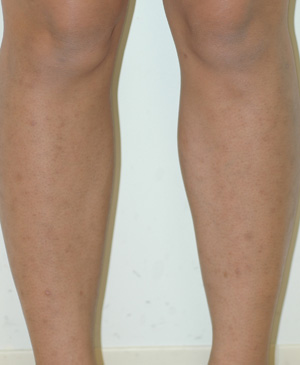
Scar Removal Before and After Pictures
“Jeff” came to us with concerns over several sun spots that had developed to his bottom lip. Although not very noticeable to others, he was self-conscious of these brown spots. Jeff first went to a consultation at another facility and, incredibly, was quoted $10,000 to remove these spots. There was no information given, options discussed, nor any sense of concern or consideration regarding how important this issue was to him. Fortunately, he had the good sense to believe there had to be a better way. That’s when Jeff found Celibre Medical. After 3 treatments spaced 4 weeks apart and with no downtime – the brown spots were completely resolved. More importantly, these outcomes were reached with only a few hundred dollars invested.
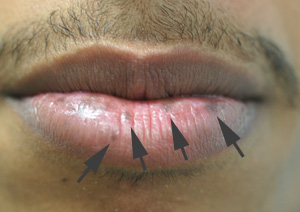
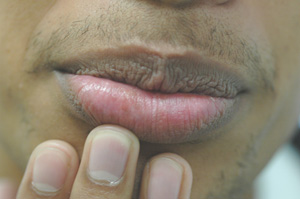
Sun Spots Before and After Pictures
At Celibre Medical, we focus on patient education. We want our patients to understand and participate in the decisions that make up their care plan. To this end, our knowledgeable medical staff are here to help you weigh the benefits and risks of our Laser treatments.
Our team would be pleased to offer a complimentary consultation to address your skin care goals. A good starting place is to gather information and view some of our patients before and after photo gallery.
At Celibre Medical, we stay at the forefront of research and best practices so that we may offer the most appropriate and effective cosmetic injections and laser resurfacing treatment plans for our valued patients.
Please contact us for your FREE consultation! 
Do you have stubborn areas of fat that won’t go away no matter how much exercise or dieting you do? It is frustrating, and if this sounds like you, then you may have researched potential fat-removing treatments that can help you decrease fat right where you need it.
But what works and what doesn’t? What’s safe and proven and what’s just hype? There are so many choices out there, finding the appropriate treatment that best fits your needs can be an overwhelming challenge!
Here are just a few of the newer technologies that you may have come across in your research: radio frequency, deep dermal tissue heating, laser-assisted liposuction, mesotherapy (injections of fat dissolving substances like Kybella), tissue massage, or different combinations of these.
Here, we’ll discuss one treatment: the VaserLipo System and Vaser HD (Vaser High Def) by Sound Surgical Technologies. The term VASER stands for: Vibration Amplification of Sound Energy at Resonance. The first generation of this technology was introduced back in March 2001. Sound Surgical Technologies then received FDA approval in September 2002 for the third generation of the system. The fundamental concept of VaserLipo is to enhance body contouring by utilizing sound waves.
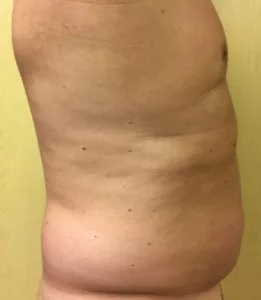
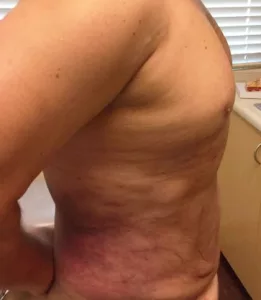
VaserLipo stands out from other traditional fat removal and body contouring treatments as it employs ultrasonic energy (sound waves) instead of laser energy to fragment fat particles. This fragmentation, known as “emulsifying” the fat, reduces the size of the particles, enabling their faster removal through aspiration or suction using conventional methods.
Just how does ultrasonic energy emulsify that fat? Think of it as placing a tuning fork on a bubble: the rapid vibration is no match for the fragile fat cell and it ruptures apart easily. Once broken down into smaller parts, the practitioner or surgeon can then remove the fat cells more quickly and easily.
While the scientific principle underlying VaserLipo is solid, does this mean that it really works to enhance fat removal and translates to better results? Many proponents of VaserLipo say that it does. They claim that the body sculpting and fat-reducing capability is superior to other, similar systems. The reason is, they claim, becuase VaserLipo selectively emulsifies the fat (selective emulsifying) which when combined with improved fluid management, can result in less bruising, less post-procedure swelling and less overall pain after your procedure. All of these factors, they claim, can help you have a speedier recovery after your procedure as well.
To further enhance your results and overall outcome, practitioners often combine VaserLipo with other technologies. For example, some practitioners will use VaserLipo for larger area where you need more fat debulking, and then follow that with SmartLipo (laser-assisted liposuction) in smaller areas. Almost any area on the body can be treated with the VaserLipo system making it very versatile.
There are a few cautionary points for the VaserLipo and VaserHD systems. Remember, these systems rely on three factors: heat, motion and suction, much like traditional liposuction which is the “gold standard” for fat removal. However, the unique factor is the ultrasonic component that these technologies use to emulsify or break down the fat particles. The heat that’s generated can make these systems tricky. In the older generations of these systems, there was inconsistent control over the tissue-heating process. This lead to too many complications following VaserLipo treatment. Although there have been some corrections, the use of these technologies still carries a higher risk of complications compared to traditional liposuction alone. The critics do tend to agree however, that the technology works.
Celibre Medical does not provide VaserLipo, nor do we offer any liposuction treatments at any of our facilities. We simply wanted to share with you our unbiased view of Vaser technology to educate and inform you as you wade through the multitude of information that is out there. We believe we can be a reliable resource for you to look to when seeking information on any cosmetic treatment. Those who achieve the highest satisfaction are the patients who actively seek comprehensive understanding and knowledge of the procedure and treatments prior to proceeding, ensuring they are well-informed about all the intricacies involved.
Again, it’s important to reiterate that these fat-removing treatments are not a substitute for a weight loss program and should never replace the benefits of healthy weight loss through diet and exercise. No matter what technology or procedure you chose, your outcome and satisfaction will rely heavily on the technique and expertise of the provider that you chose for your service. You also need to ensure that you are an appropriate candidate for the procedure. So, do your research and ask lots of questions, and remember that you are your own best advocate.
Some people have one while others have two, but no matter how many you have, one thing’s for sure: no one likes wrinkles between their eyebrows! Commonly referred to as “11s” (if you’ve got two), these wrinkles are the result of repeated contractions of three different muscle groups between the eyes. They’re typically active with facial expressions like frowning, concentrating or squinting. Over time, they become “hyperactive” and pull the inner part of your eyebrow downward and inward, deepening the lines in the middle.
Botox and Dysport are perfect for these pesky lines. By selectively relaxing these muscles, we can subtly smooth them away and give you a natural, relaxed appearance. Most people also find that Botox (Dysport) in this area helps to lift their inner brows a bit, helping them look more alert and awake.
And if the lines between your brows don’t completely go away with Botox alone, then we can carefully place a small amount of dermal filler like Restylane or Juvederm there to help plump and smooth more stubborn lines between the brows. For someone with deeper creases, the combination of these two treatments can literally transform their appearance.
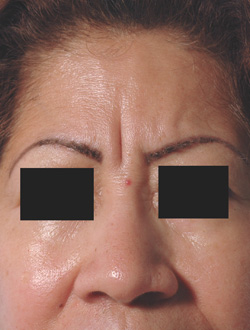
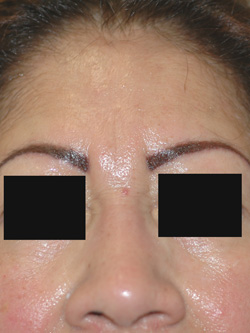
At Celibre Medical, we firmly believe that oral or topical antibiotics and other medications may be a valuable component of most acne treatment programs. However, we would like to suggest that these medications (oral antibiotics specifically) are often over-used and do not address some of the underlying causes of acne. Because of this, the acne will most likely return when the patient discontinues the antibiotics.
Current research indicates that the bacteria responsible for acne (P. acnes) are now becoming increasingly resistant to many of the mainstay acne antibiotics available. This is also true with many other bacteria that cause disease and illness. Besides this sobering reality, oral antibiotics for acne have systemic (whole body) side effects as well.
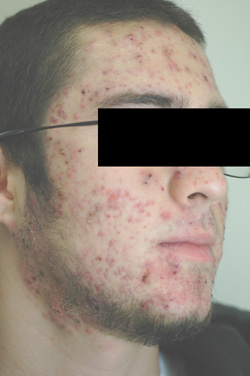
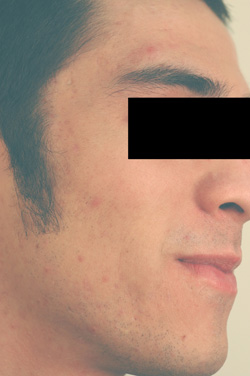
Our patients often come to us after being placed on acne antibiotics for months (sometimes over a year consecutively) without any monitoring of their treatment plan or providing other acne treatment options that don’t involve long-term use of antibiotics. At Celibre, we believe that oral antibiotics should be implemented as needed when an acne patient would benefit from a systemic effect. However, the goal is to make this a short course of action to compliment the acne laser treatments or photo-dynamic therapy.
By using class IV medical lasers, we treat one of the root causes of acne – the sebaceous (or oil) glands. By combining lasers or photo-dynamic therapy with a good skin care regimen, we are able to effectively treat and control acne, a condition that has no cure. Because acne lasers or Photo-dynamic therapy are safe for almost all patients, these provide a good option to those that are looking for a better way that doesn’t involve long-term acne antibiotic use.
If you’re a peri or postmenopausal woman, you may have heard the term “vaginal rejuvenation”. You’ve entered the next phase of womanhood and are probably experiencing a host of changes to your body—some more welcome than others! One of the problems that we hear most often about at Celibre Medical is the change in the appearance of the skin around the vagina. These folds of skin or “lips” as they’re referred to are called the labia majora.
There are three, distinct changes that can happen to the labia majora during and around the time of menopause: changes in texture, change in volume and change in color. Our vaginal rejuvenation program consists of specific interventions that can correct or reverse these changes.
Texture: Around the time of menopause, many woman notice a textural change of the skin of their labia majora. Due to decreasing or a lack of hormonal stimulation, you may notice this tissue “shrinks” and “shrivels” a bit. We can use our Sciton Profractional laser to stimulate the development of more collagen in your area. This helps it look smoother, fuller and more supple once. We typically recommend you have 2 to 3 treatments at close to monthly intervals.
Volume: The changes discussed in the above section can not only affect the texture of your skin, but also the volume of labia as well. Loss of tissue volume can cause the labia to look flat, saggy, and may even make wearing certain clothing, like pants, painful or uncomfortable. For this issue, we can inject hyaluronic acid-based dermal fillers like Restylane Lyft into the labia. This product works very well to restore volume as it powerfully attracts and absorbs water. This treatment may also improve the skin quality of the area, so it often works hand-in-hand with resurfacing and enhances your overall result. The results usually last anywhere from 6 to 12 months.
Color: If the skin on your labia has darkened over time, we can help correct this using either topical skin-lightening creams (8% hydroquinone) or q-switched lasers which targets excess melanin (skin pigment). The length of time and/or number of treatments that you’ll need can vary based on the amount of lightening you need and the size of the area that’s treated.
Again, it’s important to mention that while these changes are normal, they can be worrisome and affect your confidence and desire for intimacy. If you’re suffering with these changes, you don’t have to simply accept them. There are effective, safe solutions for you that really work!
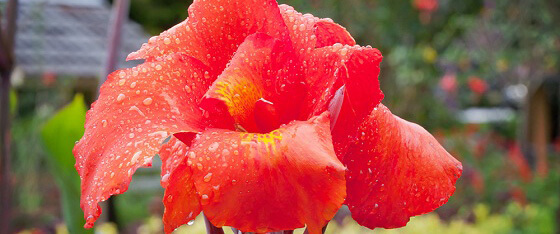
If you’re interested in Vaginal Rejuvenation, call today for more information
By now, most patients like you understand how important it is to wear sunscreen. Even though most wear sunscreen, we’re often surprised to learn that very few understand how to wear sunscreen effectively!
We spend time with our patients telling them about the importance of effectively using sunscreen for skin health. First, we discuss SPF (Sun Protection Factor). An SPF of 30 is sufficient for many and any SPF higher than 50 offers little added protection.
In addition to SPF, how you apply and how often you apply your sunscreen is important.
Lastly, remember to apply sunscreen to more than your face. Protect your scalp, ears, neck, chest, forearms and hands as they are often forgotten in your morning routine. Poikiloderma is a common cosmetic problem of red and brown discoloration to these areas due to chronic exposure to the damaging rays of the sun.
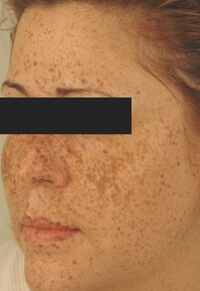
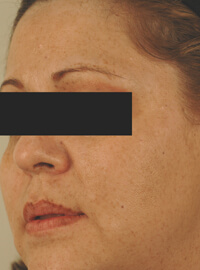
Age spot removal before and after pictures
While your eyes may be the window to your soul, they can also give away your age. The eyelid skin is extremely delicate, and unfortunately, after years of gravity, sun exposure, facial expressions, contact lenses and just about everything else we do, it can easily wrinkle, sag and lose firmness. When you couple this with the other age related changes that occur around the eyes such as increased hollowness of the upper lid and fullness or “bags” below, your eyes can become more of an “eye sore” than the focal point of your face!
Rest assured, there are things that we can do to help reverse the signs of aging eyes! Since the aging process frequently involves more than one eye structure, rejuvenation can also require more than one type of treatment to help you look your best. Here’s an example of a patient with typical aging around the eyes. She needed more than one treatment to achieve her goals, so we combined three treatments for a better outcome.
First, we used Dysport (Botox) in her crow’s feet. Smiling, talking and squinting are all culprits involved in the formation of crow’s feet—those fine lines at the outside corner of your eyes. Dysport relaxes the muscle beneath the skin, smoothing it while still allowing natural facial expression.
Next, we addressed the changes in her eyelid skin. We used fractional laser resurfacing (Sciton Profractional) to erase the finer surface lines and wrinkles, tighten and firm by stimulating collagen and improve the overall skin tone.
Finally, we used Restylane dermal filler injections to correct some of the volume loss under her eyes. Specifically, we treated the lower eyelid “tear trough” area between the lower eyelid and the cheekbone. This helped smooth the area and fill it in, giving her back a more youthful, rested look.
Eye rejuvenation can be tricky. Aging in this part of the face is usually multifaceted and so treatment should be the same. Discussing your eye rejuvenation goals with an experienced practitioner who has an in-depth knowledge of how to treat age-related changes around the eye and the proper tools to get the job done.
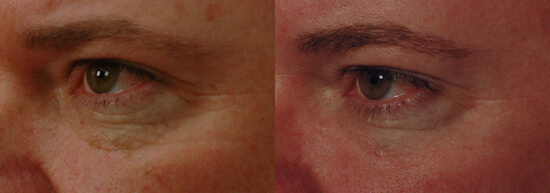
Photoaging isn’t a term that describes how we start to look in pictures as we get older! Photoaging or photodamage are terms that refer to the visible signs of skin damage caused by ultraviolet light exposure (the sun). UV light comes in the form of both natural sunlight and indoor tanning (artificial) beds. Accumulated exposure to UV can profoundly age your skin making you look much older than you actually are.
Most of us are aware of the link between sun exposure and skin cancer. But fewer realize the link between sun exposure and premature aging. Although most of us use sunscreen at the beach, only a few bother to put on sunscreen for our normal daily routine. Regular use of daily sun protection is your most powerful weapon to keep your skin looking young (or younger!) than it truly is!
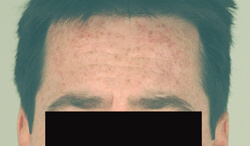
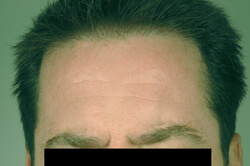
Sun spots before and after pictures
So, what does photodamage look like? Chronic, cumulative sun damage changes the texture, color and elasticity of our skin. It makes it look and feel rough. Dark patches can appear. UV also damages the deeper structural connective tissues which makes our skin thin, sallow, and saggy. These changes trigger the formation of fine lines and deep wrinkles.
If you’ve been to the dermatologist recently, you may have heard a few terms used to describe photoaging. Facial redness and spider veins refer to the development of small but visible blood vessels. Sun spots, liver spots, age spots and freckles are all terms used to describe the variety of dark, pigmented spots and patches that occur with prolonged sun exposure.
When it comes to treatments for photoaging, there are many over-the-counter creams that promise to work miracles, but buyer beware! While some stronger, physician-grade skincare products can help reduce the signs of photodamage, there is no one, single product that can reverse the signs of aging. Like Mom used to say, “An ounce of prevention is worth a pound of cure.” The best treatment for photoaging is to prevent from happening it in the first place!
If you’re really looking to improve the look, feel and luster of photodamaged skin, your best bet is laser treatment. Class IV medical lasers help with excess redness, blood vessels and spider veins, dark brown patches, and even fine lines and wrinkles.
If you choose to go this route, make sure that you find a trusted laser practitioner with a wide array of FDA-approved devices that target the specific features of your photodamage that bother you most. It is possible to reverse the signs of chronic sun exposure, but it requires finding a practice that offers a skillful, knowledgeable and comprehensive approach to the problem.
If you’re fighting acne and have failed traditional over-the-counter products and prescription medications, we have some exciting information for you. Blue light acne treatments may be just what you need to help your skin get clear.
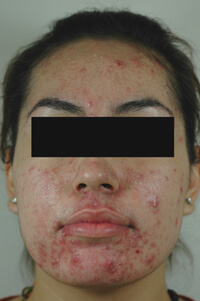
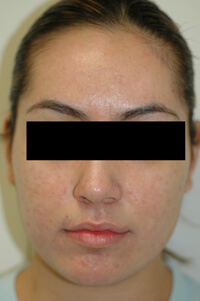 The Blu-U light is a device that uses LED technology. LED stands for light emitting diode. It isn’t a laser, but it is a medical device that has FDA approval. As you can guess by its name, Blu-U uses a blue wavelength of light which has been found to help reduce the number of acne bacteria on your skin and in doing so, decrease your acne.
The Blu-U light is a device that uses LED technology. LED stands for light emitting diode. It isn’t a laser, but it is a medical device that has FDA approval. As you can guess by its name, Blu-U uses a blue wavelength of light which has been found to help reduce the number of acne bacteria on your skin and in doing so, decrease your acne.
It is safe for all skin types, and can be used by itself to treat acne or in combination with other medications and products. Here at Celibre Medical, we use this type of LED technology combined with aminolevulanic acid (Photodynamic therapy) to treat the toughest acne cases.
It’s an exciting time for the use of light and lasers in medicine. At Celibre Medical, we are passionate about finding and using safe and effective treatments for our acne patients. We stay on the cutting edge of light and laser technology to be an industry leader in this area of expertise.
Every day at Celibre Medical, we’re asked why it is that we don’t offer cellulite and fat reduction treatments. Our answer is simple…we don’t feel that these treatments offer value to our patients and would rather have long term patients that trust us than short term profits from patients that are unhappy and feel like they wasted their money.
We understand that there’s demand for non-surgical fat reduction and cellulite treatments. Even for the fittest of us, cellulite and stubborn areas of fat can be frustrating because they limit our comfort in certain types of clothes as well as our ability to even wear certain things! We’d love to see safe, effective non-surgical treatments for this stubborn problem too, but we must honestly tell you that the technology is just not there (as of the beginning of 2018).
Let us make an important clarification: fat reduction is not the same as cellulite reduction. Although some may tout treatments for the two as one-and-the-same and claim their complementarity, it is important to note that they are two separate problems. You need to make sure the procedure you’re researching treats the specific problem that you’re wanting to correct. Common procedures for fat and/or cellulite reduction include heating or freezing the fat, sometimes in combination with suction or message, radiofrequency skin tightening, and various non-FDA-approved injections (Mesotherapy) that purport to “melt”’ fat. Other names that you’ve heard may include Coolscuplt, LipoZap, LipoDissolve, CoolLipo, Velashape and VelaSmooth. Despite being FDA-approved, we want to warn you that some of these options lack support from peer-reviewed research or the American Society of Plastic Surgeons (ASPS). We encourage you to conduct your own research.
Efficacy. Here at Celibre, that’s the name of our game. We want to be know as a practice that only safe and effective treatments. We’ve researched all the available treatments mentioned above and few more and found them to be unreliable in terms of how well they work. After consulting with patients and practitioners well-versed in these treatments, we have confirmed that prescribing diet and exercise serves as an additional component to them. Now, what truly holds the secret to success with these treatments? Is it the diet and exercise that’s working or the treatment itself? If a treatment can’t reliably stand on its own without the diet and exercise, then we won’t offer it.
Value. We provide our patients with exceptional value for the treatments we offer. That means that we talk up-front with them about what we’re suggesting, what it can and can’t do to help them achieve their goals and the results they can expect. Our motto is under-promise and over-deliver on expectations. Cellulite and fat reduction treatments won’t reliably do this. Therefore, we don’t think they provide good value for you and they don’t enhance the value of our practice.
Lastly, is focus. Laser skincare and injections is the focus of our practice. Although we’d like to be all things to all patients, we know we are very good at what we do and don’t try to offer every new service out there. We stick to what we know works well.
We understand there is growing interest in non-surgical cellulite and fat reduction treatments. We are as excited as you to see what comes next, but we’re not impressed with the current technologies. We evaluate and test latest and greatest fat and cellulite reduction options and demand reliable, reproducible results before we consider integrating it into our practice. Our commitment is to patient satisfaction and we believe this focus is what makes us unique in the world of cosmetic dermatology.
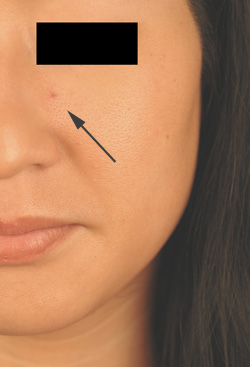
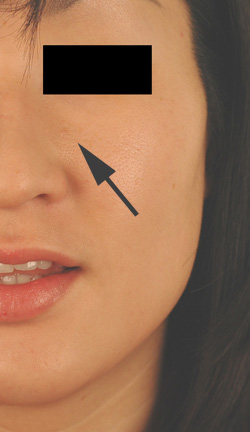
Are you seeing spots? Little red bumps on the chest, neck or back? Does it seem like they pop up overnight? If so, don’t worry! It’s likely that you are developing cherry hemangiomas – small, bumpy growths of blood vessels (or capillaries) in your skin.
In some cases, cherry hemangiomas are related to prolonged sun exposure. Most of the time, however, they are related to genetics and just one of those things that happens as we get older.
If you have either cherry hemangiomas or spider hemangiomas and you’d rather not, a hyfrecator (cauterization) can easily and effectively remove them! One word of advice though: it’s better to treat them sooner rather than later! In our experience, newer cherry hemangiomas respond better to laser treatment than older ones.
There are some things that get better with age: wine, cheese, and a good pair of blue jeans. Unfortunately, most of us know that our skin doesn’t make the list. If you’ve noticed unwelcomed signs of aging skin, perhaps you’ve tried skincare products, had laser therapy or are considering all the above!
Science has helped us better understand how and why we age. Generally, there are two types of factors that influence the changes we experience through the aging process: intrinsic and extrinsic factors.
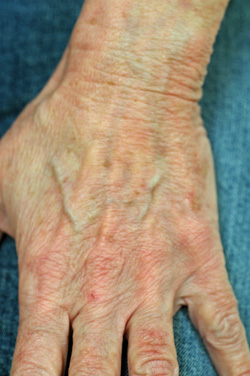
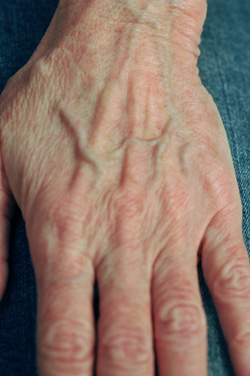 Extrinsic factors are the things outside of our bodies that influence the aging process. Sun exposure, environmental pollution, and smoking are all examples of extrinsic aging factors. Recently, research has suggested that certain lifestyle factors can influence how we age. Marital status, stress and depression can all accelerate aging.
Extrinsic factors are the things outside of our bodies that influence the aging process. Sun exposure, environmental pollution, and smoking are all examples of extrinsic aging factors. Recently, research has suggested that certain lifestyle factors can influence how we age. Marital status, stress and depression can all accelerate aging.
Intrinsic factors are unique to each of us and can affect how we age. Genetic predisposition to disease and hormonal levels are two examples of this type of factor. Sometimes, the two types of factors can compound one another. For example, it has long been recognized that Asians who smoke have a higher rate of facial lines and wrinkles than non-Asian smokers.
Consider too that the extrinsic factors of anxiety, stress and depression trigger internal hormonal changes that can affect aging. All this is to say that there is overlap between the two types, and sometimes, there is little we can do to control both.
If you’ve read this far, then you’re very interested in your aging process and highly motivated to take steps to slow it down. Despite all the technological advances and scientific breakthroughs that have contributed to the development of the anti-aging industry, there is one, simple item that most people forget about every day that can make the biggest difference in our skin: sunscreen.
Ultraviolet radiation (sun exposure) is the number one extrinsic aging factor. You could spend thousands on injections and laser procedures, but if you’re not wearing sunscreen every single morning, you might be throwing that money away! It’s true! Protect your skin and the investment you make in it by applying a readily available sunscreen every morning. It takes just seconds a day, the return on your investment is huge, and we promise it is the number one thing that you can do to slow down the effects of time and help your skin age more gracefully!
Age Spot Removal Before and After Photos
Laser Treatments for Age Spots
Laser Age Spot Removal Free Consultations
Syringoma are small, non-cancerous growths that most commonly show up on your lower eyelids and upper cheeks. They are more common in women than men, and we see them more often in Asian women than any other patients. While they’re not dangerous, they can be cosmetically undesirable. You might think that removing these on the delicate eyelid skin would be impossible, but it isn’t! We’ve performed successful syringoma removal for many patients, so don’t let you fear hold you back from seeking treatment.
Many of our patients think that we’ll need to use an aggressive treatment, like a fractional laser. We like to think of this as using a sledgehammer to pound in a nail—it’s overkill. Sure, we could use a form of laser resurfacing, but syringoma are so small that the trouble we’d go through just wouldn’t be worth all the fuss.
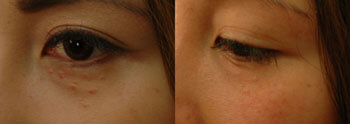
Here are some before and after photos of one of our patients in the Los Angeles area who was treated with hyfrecation.
There is another treatment that is much easier but works just as well: hyfrecation. Hyfrecation involves using a thin, needle-like probe that is attached to an adjustable electric current. This tiny probe can be used very precisely to target the individual syringoma. The electrical current heats the tissue which destroys the bumps. It’s a fast, simple procedure that works very well.
If you have syringoma and are ready to get rid of them, give us a call today.
The short answer to this common question is no. Unfortunately, we still don’t have a cure for Rosacea. And we really don’t have a solid understanding of what exactly causes it either. The factors causing Rosacea are varied and they often can be different for different patients. This also makes finding one, single treatment that is effective for everyone a challenge as well. If you struggle with Rosacea but haven’t tried laser treatments, perhaps it’s time.
Many patients like you suffering with Rosacea come to us because they have failed medication options. We often find that many patients don’t understand the nature of their condition and that it isn’t curable. They often don’t know that Rosacea is a triggered process, meaning that there are things that can be done to avoid a flare.
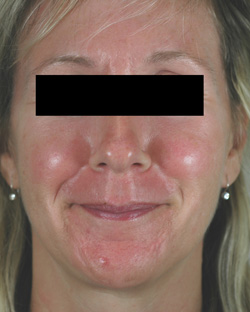
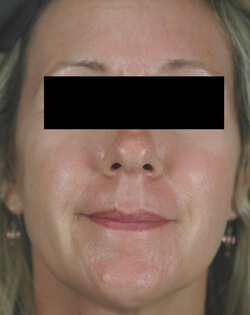
Rosacea before and after photos
During consultation and treatment, we help patients like you suffering with Rosacea to better understand and manage the condition. While Rosacea may not curable, it’s certainly manageable. We use safe, proven light-based and laser treatments such as pulsed dye lasers and PDT, or photodynamic therapy, to reduce the redness and excessive blood vessels triggered by Rosacea. These treatments offer dramatic improvement—usually much more than with prescription oral and topical medications.
When you visit, we take the time to discuss your Rosacea with you and help you identify possible triggers such as spicy foods, alcohol, heat or coffee in addition to offering an effective laser treatment option. While we know there’s no cure Rosacea, and we’ve helped thousands of patients like you in the Los Angeles and torrance area take control of and improve on this frustrating skin condition.
